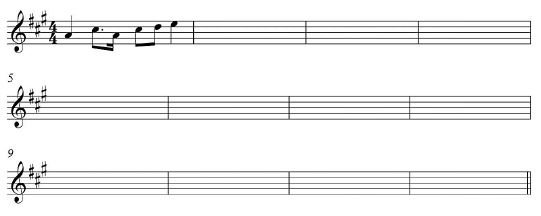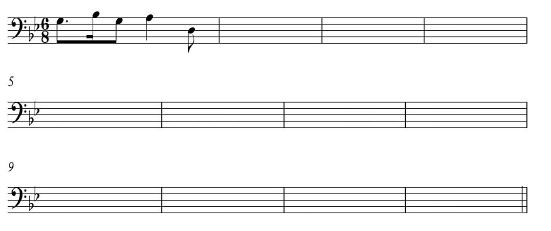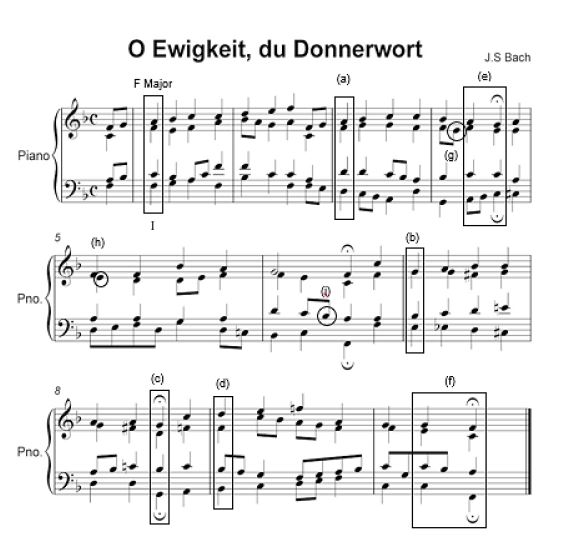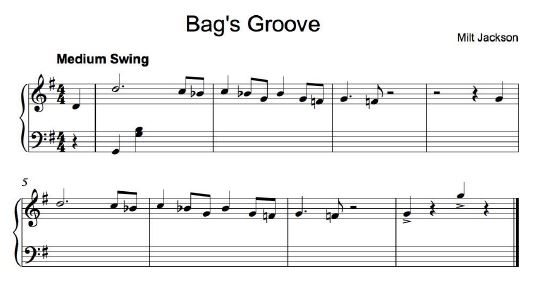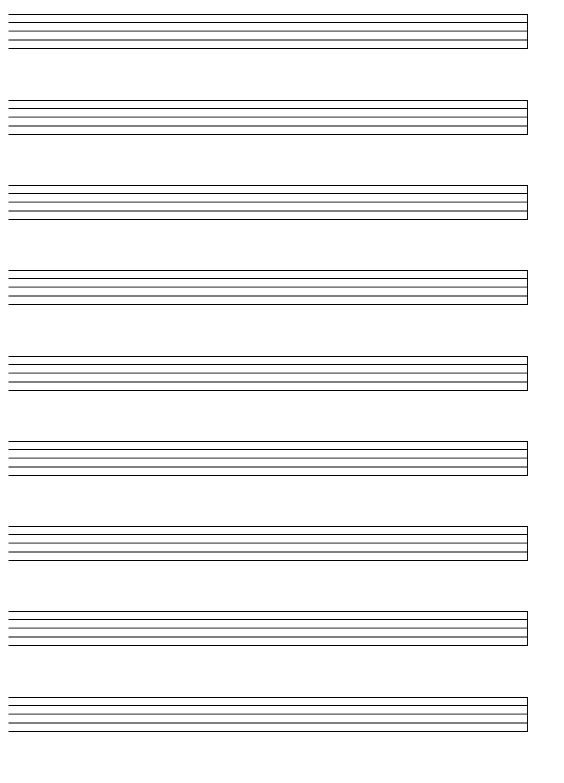MUSIC PAPER 1 GRADE 12 QUESTIONS - NSC PAST PAPERS AND MEMOS SEPTEMBER 2016
Share via Whatsapp Join our WhatsApp Group Join our Telegram GroupMUSIC
PAPER ONE(P1)
GRADE 12
EXAM PAPERS AND MEMOS
SEPTEMBER 2016
INSTRUCTIONS AND INFORMATION
- This question paper consists of FIVE sections, namely SECTIONS A, B, C, D and E.
- Answer SECTION A in pencil only in the spaces provided on this question paper.
- Answer SECTION B and C or D or E in blue or black ink in the ANSWER BOOK provided.
- Number the answers correctly according to the numbering system used in this question paper.
- The last page of this question paper is manuscript paper intended for rough work. You may remove this page.
- You may NOT have access to any musical instrument for the duration of this examination.
- Use the table on the next page as a guide for mark and time allocation when answering each question.
- Write neatly and legibly.
MARKING GRID
SECTION | QUESTION | MARKS | MARKER | MODERATOR |
A: Theory of Music (COMPULSORY) | 1 | 20 | ||
2 | 15 | |||
3 | 10 | |||
4 | 15 | |||
SUBTOTAL | 60 | |||
AND | ||||
B: (COMPULSORY) | 5 | 20 | ||
SUBTOTAL | 20 | |||
AND | ||||
C: WAM | 6 | 10 | ||
7 | 10 | |||
8 | 10 | |||
9 | 10 | |||
SUBTOTAL | 40 | |||
OR | ||||
D: JAZZ | 10 | 10 | ||
11 | 7 | |||
12 | 8 | |||
13 | 15 | |||
SUBTOTAL | 40 | |||
OR | ||||
E: IAM | 14 | 10 | ||
15 | 8 | |||
16 | 7 | |||
17 | 15 | |||
SUBTOTAL | 40 | |||
GRAND TOTAL | 120 | |||
QUESTIONS
SECTION A: THEORY OF MUSIC (COMPULSORY)
Answer QUESTION 1, QUESTION 2.1 OR QUESTION 2.2, QUESTION 3, AND QUESTION 4.1 OR QUESTION 4.2.
Answer the questions in the spaces provided on this question paper.
QUESTION 1
Study the extract from Oboe Sonata, Op. 166 by C. Saint Seans below and answer the questions that follow.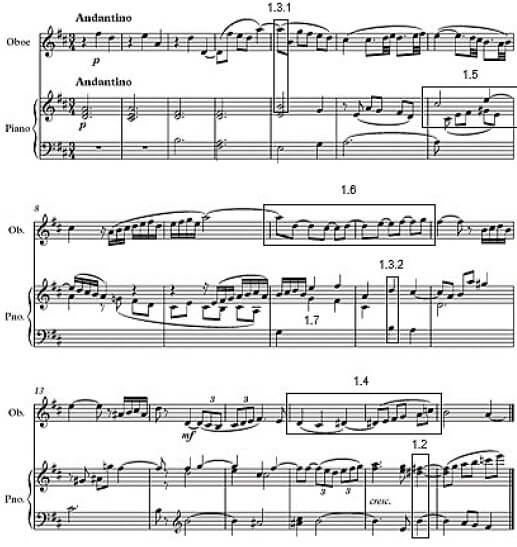
1.1 Name the key of this extract. (1)
1.2 Name the type of triad at 1.2, for example diminished triad. (1)
1.3 Give the intervals marked 1.3.1 and 1.3.2, for example major 2nd.
1.3.1 ——————————————————————————————
1.3.2——————————————————————————————(2)
1.4 Transpose the oboe part in bar 16 and 17 for Clarinet in Bb. Insert a new key signature. 
1.5 Re-write bar 7 of the piano part in half the note values. Insert a new time signature. 
1.6 Improve the grouping in bars 10 and 11.
1.7 Why are rests not used on beat 2 and 3 in the bass clef in bar 10? (1)
1.8 Write the following scales or modes according to the given instruction:
1.8.1 B Dorian mode, descending without key signature. Use the bass clef and minums. 
1.8.2 C melodic minor scale, ascending, with key signature. Use the alto clef and minums. 
[20]
QUESTION 2
ANSWER EITHER QUESTION 2.1 OR QUESTION 2.2.
2.1 Use the opening motif below and complete a 12-bar melody in ABA-form for any single-line melodic instrument of your choice. Indicate the instrument for which you are writing and add dynamics and articulation marks, as well as a tempo indication.
Instrument: —————————————————————————————————————————————————
The melody will be marked according to the criteria below:
DESCRIPTION | MARK ALLOCATION | CANDIDATE’S MARK |
Instrument choice | 1 | |
Form and cadential points | 3 | |
Musicality | 8 | |
Correct notation | 1 | |
Dynamics and articulation | 2 | |
TOTAL | 15 |
[15]
OR
2.2 Use the opening motif below and complete a 12-bar melody in ABA-form for any single-line melodic instrument of your choice. Indicate the instrument for which you are writing and add dynamics and articulation marks, as well as tempo indication.
Instrument: —————————————————————————————————————————————————
The melody will be marked according to the criteria below:
DESCRIPTION | MARK ALLOCATION | CANDIDATE’S MARK |
Instrument choice | 1 | |
Form and cadential points | 3 | |
Musicality | 8 | |
Correct notation | 1 | |
Dynamics and articulation | 2 | |
TOTAL | 15 |
[15]
QUESTION 3
Study the extract from O Ewigkeit, du Donnerwort by J.S. Bach below and answer the questions that follow.
3.1 Figure the chords marked (a) – (d) on the score. Use EITHER figuring symbols below the score OR chord symbols above the score. Note the example answer in bar 1. (4)
3.2 Name the cadences at (e) and (f). Write only the name of the cadence below the score in the block provided. (2)
3.3 Name the type of non-chordal notes at (g) to (i).
(g) —————————————————————————————————————————————————
(h) —————————————————————————————————————————————————
(i) ————————————————————————————————————————————————— (3)
3.4 Name the relative key (major or minor) of this extract. (1)
[10]
QUESTION 4
Answer EITHER QUESTION 4.1 (WAM) OR QUESTION 4.2 (JAZZ).
4.1 Complete the four-part vocal harmonisation below by ading the alto, tenor and bass parts. Use at least TWO non-chordal notes.
The harmonisation will be marked according to the criteria below:
DESCRIPTION | MARK ALLOCATION | CANDIDATE’S MARK |
Choice of chords | 14 (Minus ½ mark per mistake) | |
Correctness | 14 (Minus ½ mark per mistake) | |
Use of non-chordal notes | 2 | |
30 (÷ 2) | ||
TOTAL | 15 |
[15]
OR
4.2 Complete the piece below by adding suitable harmonic material in the bass clef. Ensure that you write in the style of Ragtime.
The harmonisation will be marked according to the criteria below:
DESCRIPTION | MARK ALLOCATION | CANDIDATE’S MARK |
Choice of chords | 16 (2 per bar) (Minus ½ mark per mistake) | |
Correctness | 8 (Minus ½ mark per mistake) | |
General impression | 6 | |
30 (÷ 2) | ||
TOTAL | 15 |
[15]
TOTAL SECTION A: 60
SECTIONS B, C, D, E: GENERAL MUSIC KNOWLEDGE
Answer SECTION B (COMPULSORY)
AND SECTION C (Western Art Music)
OR SECTION D (Jazz)
OR SECTION E (Indigenous African Music)
Answer these questions in an ANSWER BOOK.
SECTION B: GENERAL (COMPULSORY)
QUESTION 5
5.1 Four options are provided as possible answers to the following questions. Choose the answer and write only the letter (A–D) next to the question number in the ANSWER BOOK, for example 5.11 E.
5.1.1 The three types of minor scales are:
- Harmonic, Pentatonic, Chromatic.
- Natural, Blues, Major.
- Harmonic, Melodic, Natural.
- Wholetone, Natural, Chromatic (1)
5.1.2 Which note is raised in a chord when using a Tierce de Picardie?
- 1
- 3
- 7
- 5 (1)
5.1.3 The Cor anglais belongs to which instrumental family?
- Brass
- Percussion
- Woodwind
- Strings (1)
5.1.4 Rondo is usually associated with which movement of a sonata/symphony?
- 1st
- 2nd
- 3rd
- 4th (1)
5.1.5 How many semi-quavers fit into a dotted semibreve?
- 8
- 14
- 12
- 24 (1)
5.1.6 Which THREE elements define musical form?
- Variation, Barlines, Melody.
- Tone, Repetition, Articulation.
- Contrast, Dynamics, Tone.
- Repetition, Variation, Form. (1)
5.1.7 Which ONE of the following is not an articulation marking?
- Staccato
- Tenuto
- Fermata
- Legato (1)
5.1.8 A cappella refers to a …
- sudden increase in tempo.
- concerto soloist.
- work performed without accompaniment.
- trombone mute. (1)
5.1.9 A chromatic interval refers to an interval where …
- two notes sound together.
- both intervals are in the given key.
- one or both notes are inverted.
- one or both notes are not in the given key. (1)
5.1.10 A Coda is generally found …
- after a key change.
- at the end of the piece.
- within the development.
- before the exposition. (1)
5.2 Answer the following questions.
5.2.1 What does the accronym SAMRO mean? (1)
5.2.2 What is the function of SAMRO? (1)
5.2.3 Michael Jackson died in 2009. In what year will the copyright expire on his compositions? (1)
5.3 Give THREE ways in which a new composition can be registered. (3)
5.4 Complete the following by saying whether the following statements are TRUE or FALSE.
5.4.1 Pirate recordings are legitimate recordings that are illegally copied.
5.4.2 Music piracy does not have a negative effect on the music industry.
5.4.3 Copyright allows composers to reproduce and distribute their music.
5.4.4 Online piracy refers to the downloading of films only. (4 x 1) (4)
TOTAL SECTION B: 20
Answer SECTION C (Western Art Music)
OR SECTION D (Jazz)
OR SECTION E (Indigenous African Music)
SECTION C: WESTERN ART MUSIC (WAM)
QUESTION 6
6.1 How many symphonies did Beethoven compose? (1)
6.2 What is the similarity between Fingals Cave Op.26 and the opening of The Magic Flute? (1)
6.3 What is the difference between a symphony and symphonic poem? (2)
6.4 Which ancient secret order was referenced in The Magic Flute? (1)
6.5 Name ONE famous work by Mendelssohn (Other than Fingal’s Cave). (2)
6.6 Apart from opera, give TWO genres in which Mozart composed. (2)
6.7 What is the difference between opera seria and opera comique? (2)
[10]
QUESTION 7
7.1 The Mannheim School played a significant role in the development of the orchestra and symphony.
7.1.1 What is the Mannheim School? (2)
7.1.2 Give FIVE stylistic developments that the Mannheim School introduced. (5)
7.2 Match the voice type in COLUMN B with the character in COLUMN A. Write only the letter (A–C) next to the question number (7.2.1–7.2.3) in the ANSWER BOOK, for example 7.2.4 E.
| COLUMN A | COLUMN B |
7.2.1 Sarastro | A Coloratura Soprano |
(3 x 1) (3)
[10]
QUESTION 8
8.1 Use the following list of elements to write a paragraph on the style characteristics of the Romantic period.
- Melody (1)
- Harmony (1)
- Tonality (1)
- Texture (1)
- Rhythm (1)
8.2 Describe the Hebrides Overture Op. 26 by Mendelssohn by giving the key, form and basic instrumentation of the work. (4)
8.3 Where did Mendelssohn find the inspiration for the Hebrides Overture? (1)
[10]
QUESTION 9
Write an article for the Gramophone magazine readers, where you describe the FIRST and FOURTH movement of Beethoven’s Symphony no.6 Op. 68. Refer to the following guidelines:
- Movement titles (2)
- Time signatures (2)
- Keys (2)
- Forms (2)
- Any THREE features of the movements (6)
- Style and language (2) (16 ÷1.6)
[10]
TOTAL SECTION C: 40
OR
SECTION D: JAZZ
QUESTION 10
10.1 In what city is jazz said to have originated? (1)
10.2 Which jazz group composed “vary-oo-vum”? (1)
10.3 Other than Miriam Makeba, give TWO examples of an early jazz singer. (2)
10.4 Where did Kwela originate? (1)
10.5 Which style of jazz makes use of both rock and funk? (1)
10.6 What instrument does Abdullah Ibrahim play? (1)
10.7 Which South African group released the album “Township Bop”? (1)
10.8
10.8.1 What is the name of Miriam Makeba’s international hit? (1)
10.8.2 In what year was this song released? (1)
[10]
QUESTION 11
You are asked to write a short press release for an upcoming tribute to Spokes Mashiyane. Your article should include the following information:
- His main instrument (1)
- Musical style and characteristics of that style (4)
- Musical inspiration (1)
- ONE album (1)
[7]
QUESTION 12
12.1 Write brief notes on the jazz group Voice. Your notes should include the following:
- TWO band members
- Style and Influences of the group (4)
12.2 Say whether the following statements are TRUE of FALSE.
12.2.1 Bebop makes use of fast scales and arpeggio.
12.2.2 Marabi style is deeply rooted in ragtime and blues.
12.2.3 Kwela consists of SEVEN different chord changes.
12.2.4 Mbaqanga is a style of South African music with Xhosa roots. (4 x 1) (4)
[8]
QUESTION 13
The Jazz Epistles were the first important band of its kind in South Africa.
Write an essay outlining the bands career with reference to the following points:
- Band members (6 ÷ 2) (3)
- Instruments (6 ÷ 2) (3)
- Characteristics of the music (5)
- The characterisation of Jazz during the Apartheid era (2)
- ONE album (1)
- Style and language (1)
[15]
TOTAL SECTION D: 40
OR
SECTION E: INDIGENOUS AFRICAN MUSIC (IAM)
QUESTION 14
14.1 An Uhadi belongs to which musical instrument category? (1)
14.2 What is a Chronicler? (2)
14.3 Define the term Ululation. (1)
14.4 Which style would you associate with Dolly Rathebe? (1)
14.5 What is meant by ‘The mixed structural form’? (2)
14.6 Give a modern term for ‘Mouth Drumming’ (1)
14.7 Give TWO style characteristics of free kiba music. (2)
[10]
QUESTION 15
You are asked to write a short press release for an Isicathamiya choir competition.
Your article should include the following information:
- Definition of the word (2)
- Characteristics of the music (4)
- ONE important album and its composer/s (2)
[8]
QUESTION 16
Write a Wikipedia entry on Afro Soul, where you describe the style/characteristics of the music as well as the typical instrumentation. Give TWO examples of South African Afro Soul artists.
- Style/Characteristics (3) ∙
- Instrumentation (4 ÷ 2) (2) ∙
- TWO artists (2)
[7]
QUESTION 17
Write an essay where you describe Maskandi music. Include the following aspects in your essay:
- Cultural origins (2) ∙
- Typical instrumentation (5) ∙
- Style characteristics of the music (5)
- THREE artists that were influential in exposing Maskandi to the international market. (3)
[15]
TOTAL SECTION E: 40
ROUGH WORK
